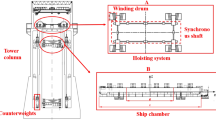Abstract
The hydro-floating ship lift originally invented in China is a major innovation in the field of navigation technology. The shaft water levels synchronization of its unique hydraulic-driven system plays a crucial role in reducing the torque of the synchronous shafts and ensuring the safety and stability operation of the ship lift. This study aims to investigate the muti-shaft water level synchronization and the flow velocity uniformity of the combined type hydraulic-driven system. Based on the theory of residual energy, a new index m2 proposed in this study is more suitable for evaluating the flow velocity uniformity of the combined hydraulic-driven system. Finally, the critical value of m2 =75 is calculated via the results of the scaled physical mode test as the threshold of water flow uniformity, and it provides a basis for determining the reasonable height of the pressure stabilizing chamber.
Similar content being viewed by others
References
Ma H. Q., Cao, X. X. Research on the key technologies of hydraulic new type ship lift [J]. Journal of Hydraulic Engineering, 2018, 49(4): 446–455, 463(in Chinese).
Hu Y. A., Xue S., Li Z. H. Layout and operation simulation analysis of hydro-floating ship lift with lift weight of 2×1000 t [J]. Port and Waterway Engineering, 2020, (11): 1–6(in Chinese).
Xue S., Hu Y. A., Li Z.H. et al. Research of orifice flux distribution law of non-equal inertia hydraulic synchronous system for hydro-floating ship lift [C]. 35th World Congress of the International Association for Hydro Environment Engineering and Research, Chengdu, China, 2013.
Zhang Y. N., Li X. F., Guo Z. Y. et al. Interior non-uniformity of acoustically excited oscillating gas bubbles [J]. Journal of hydrodynamics, 2019, 31(4): 725–732.
Wang H., Shen Q., Zhu C. et al. Formation and uniformity of bubbles in highly viscous fluids in symmetric parallel microchannels [J]. Chemical Engineering Science, 2021, 230: 116166.
Wu G., Yan Z., Zhuang D. et al. Design method and application effects of embedded-clapboard distributor on refrigerant distribution among multi-tubes of microchannel heat exchangers [J]. International Journal of Refrigeration, 2020, 119: 420–433.
Tao H. G., Chen H. X., Xie J. L. et al. An alternative approach to quantifying fluid flow uniformity based on area-weighted average velocity and mass-weighted average velocity [J]. Energy and Buildings, 2012, 45: 116–123.
Huai W. X., Zhang J., Katul G. G. et al. The structure of turbulent flow through submerged flexible vegetation [J]. Journal of Hydrodynamics, 2019, 31(2): 274–292.
Wang Z. Ship lock design [J]. Beijing, China: Water Resources and Electric Power Press, 1992, 159–185(in Chinese).
Cheng H. Y., Bai X. R., Long X. P. et al. Large eddy simulation of the tip-leakage cavitating flow with an insight on how cavitation influences vorticity and turbulence [J]. Applied Mathematical Modelling, 2020, 77: 788–809.
Khayrullina A., van Hooff T., Blocken G. et al. Validation of steady RANS modelling of isothermal plane turbulent impinging jets at moderate Reynolds numbers [J]. European journal of mechanics, B, Fluids, 2019, 75: 228–243.
Long Y., Long X. P., Ji B. et al. Verification and validation of URANS simulations of the turbulent cavitating flow around the hydrofoil [J]. Journal of Hydrodynamics, 2017, 29(4): 610–620.
Achari A. M., Das M. K. Application of various RANS based models towards predicting turbulent slot jet impingement. International Journal of Thermal Sciences, 2015, 98: 332–351.
Author information
Authors and Affiliations
Corresponding author
Ethics declarations
Ethical approval: This article does not contain any studies with human participants or animals performed by any of the authors.
Additional information
Compliance with Ethical Standards
Conflict of Interest: The authors declare that they have no conflict of interest.
Informed consent: Informed consent was obtained from all individual participants included in the study.
Biography: Bo Wu (1991-), Male, Ph. D. Candidate
Rights and permissions
About this article
Cite this article
Wu, B., Hu, Ya. & Xue, S. Study on the flow field uniformity of hydro-floating ship lift combined type hydraulic-driven system based on the residual energy theory. J Hydrodyn 34, 1156–1161 (2022). https://doi.org/10.1007/s42241-022-0079-3
Received:
Revised:
Accepted:
Published:
Issue Date:
DOI: https://doi.org/10.1007/s42241-022-0079-3




